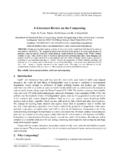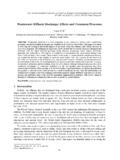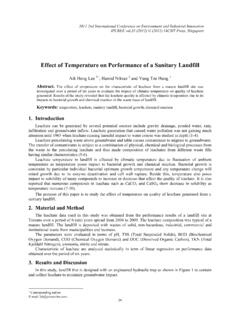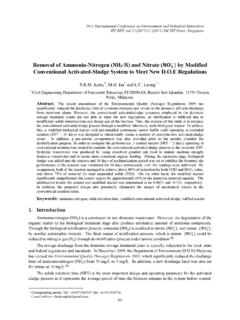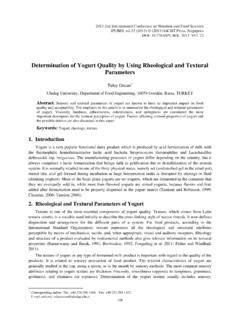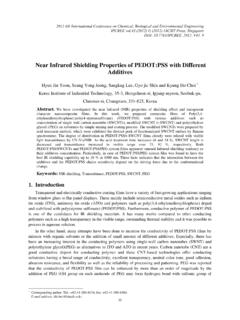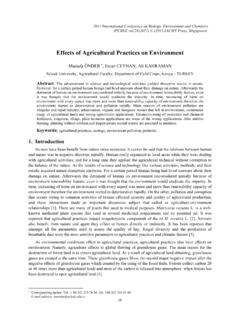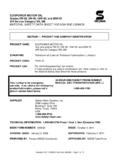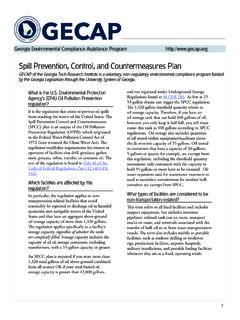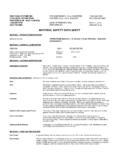Transcription of Application of Diagnostic Ratios of PAHs to …
1 Application of Diagnostic Ratios of PAHs to characterize the pollution Emission Sources Marek Tobiszewski Department of Analytical Chemistry, Chemical Faculty, Gda sk University of Technology (GUT), ul. G. Narutowicza 11/12, 80-233 Gda sk, Poland Abstract. The paper summarizes the potential of Application of parent polycyclic aromatic hydrocarbons (PAHs) to identify their emission sources. Four parent PAHs Diagnostic Ratios are used for this purpose: anthracene/(anthracene + phenanthrene), fluoranthene/(fluoranthene + pyrene), benzo[a]pyrene /(benzo[a]pyrene + chryzene) and indeno[1,2,3-c,d]pyrene/(indeno[1,2,3-c, d]pyrene + benzo[g,h,i]perylene).
2 The compounds of each ratio have the same molar mass and similar physicochemical parameters, so they are characterized by similar environmental fate. Thus, the Ratios ideally remain constant from the moment of emission to sample collection and analysis. The Ratios allow to identify PAHs emissions from unburned petroleum, petroleum combustion and biomass burning. The example of Application to surface water samples is presented. Keywords: Polycyclic aromatic hydrocarbons, molecular markers, organic pollutants.
3 1. Introduction Polycyclic aromatic hydrocarbons (PAHs) are group of environmental pollutants of special concern. They are mutagenic, toxic and carcinogenic [1]. PAHs originate from natural processes, like bush fires, volcanic eruptions or diagenesis [2] but they also come from anthropogenic emission sources, like combustion of liquid petroleum fuels [3], biomass [4] and coal [5]. They are found in crude oil and petroleum based fuels, therefore they can be emitted to the environment during spills of petroleum containing products [6].
4 PAHs are emitted and found in the environment as a mixture of pollutants from this group. PAHs emission profile from unburned fuel is characterised by the domination of light, two and three ring PAHs, whereas PAHs emission profile from burning processes is characterised by the domination of four and five ring PAHs. Compared to combustion PAHs, petroleum related PAHs are characterised by higher content of alkyl substituted derivatives [7]. PAHs emitted to the environment undergo degradation and may be transferred to other phases.
5 Therefore source characteristic PAH emission profiles can be altered during PAH environmental fate. To minimize the changes of PAH profile after emission to the environment, instead of taking into consideration the whole profile, the ratio of just two compounds is calculated. These compounds have the same molar mass, so their physicochemical parameters water solubility, vapour pressure, lipophilicity, sorption coefficients are also similar [8]. Thus, the relative ratio of the two isomers ideally remains constant from the moment of emission to the sample collection.
6 The aim of the study is to determine the sources of PAHs in surface water samples, collected in the Gda sk region. Applicability of PAH Diagnostic Ratios to surface water samples will be evaluated. 2. Application of Diagnostic Ratios The characteristic values of PAH Diagnostic Ratios [9] based on parent PAHs are presented in the Table 1. They allow to distinguish between PAH pollution originating from petrogenic (liquid fuels spills), pyrolytic (combustion of fuels) and burning biomass or coal sources.
7 2014 5th International Conference on Environmental Science and Technology IPCBEE (2014) (2014) IACSIT Press, Singapore DOI: 2014. V69. 9 41 Table 1: Characteristic Diagnostic Ratios values for particular pollution emission sources. Diagnostic ratio Petrogenic Fuel combustion Coal, grass, wood burning ANT/(ANT + PHE) < > - FLA/(FLA + PYR) < > BaA/(BaA + CHR) < > IcdP/(IcdP + BghiP) < > ANT anthracene; BaA benzo[a]anthracene; BghiP benzo(ghi)pyrene; CHR chrysene; FLA fluoranthene; IcdP indeno(cd)perylene; PHE phenanthrene; PYR pyrene.
8 PAH Diagnostic Ratios can be applied to water samples. They have been successfully applied to identify the river sections influenced by biomass burning processes, traffic related emissions and effluent from petrochemical industry wastewater treatment plant [10]. Analysis of bottom sediments allows to assess the range of oil spills, as well as the rates of oil weathering processes [11]. To identify the emission sources of PAHs, affecting the quality of sediments, the analysis of mussel tissues are applied, instead of sediment analysis [12].
9 The analysis of PAHs present in sediment cores, together with sediment dating, gives information on historical activities of particular PAH sources. Shifts from wood burning, to coal and coke utilization and oil combustion as main energy sources were identified [13]. Other study showed shift from softwood burning to petroleum combustion as the sources of bottom sediment PAH pollution [14]. 3. Materials & Methods Samples were collected along surface water stream in five sampling points numbered from 1 to 5.
10 Sampling point 1 is not in the very close neighborhood of any emission source, sampling point 2 is near to discharge from industrial facility, while sampling points 3, 4 and 5 are located next to road. Isolation and enrichment of PAHs was performed by SPE. The cartridges were filled with LiChrolut RP 18 sorbent and were conditioned with 3 ml of dichloromethane, 2 3 ml of methanol and 3 ml of deionized water. Then the 200 ml of the samples, with flow rate 2 ml min-1, were passed through the SPE cartridges and were dried in the air for 30 min.
